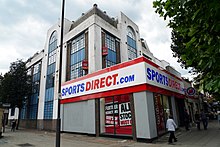
Omnichannel retail strategy, originally also known in the U.K. as bricks and clicks,[citation needed] is a business model by which a company integrates both offline (bricks) and online (clicks) presences, sometimes with the third extra flips (physical catalogs).
By the mid-2010s, many (physical store) retailers offered ordering via their website, mobile phone apps, as well as by voice over the telephone.[3] The wide uptake of smartphones made the model even more popular, as customers could browse and order from their smartphone whenever they had spare time.[4] The model has historically also been known by such terms as clicks and bricks, click and mortar, bricks, clicks and flips, and WAMBAM, i.e. "web application meets bricks and mortar".[5])
- ^ "About Us". Sports Direct. Retrieved 22 October 2014.
- ^ Ruddick, Graham (2014-07-16). "Sports Direct and Mike Ashley: the rise of Britain's craziest retailer". The Daily Telegraph. Retrieved 22 October 2014.
- ^ Bogaisky, Jeremy. "Retail In Crisis: These Are The Changes Brick-And-Mortar Stores Must Make". Forbes.com. Archived from the original on March 2, 2014. Retrieved 17 October 2014.
- ^ "How Mobile Is Transforming the Shopping Experience in Stores". Think With Google. Archived from the original on 6 May 2017. Retrieved 24 October 2014.
- ^ "Web application meets bricks and mortar". Web application meets bricks and mortar : A Dictionary of the Internet Oxford Reference (p. 315). Oxford University Press. January 2009. doi:10.1093/acref/9780199571444.001.0001. ISBN 9780199571444. Retrieved 30 September 2013.
{{cite book}}:|website=ignored (help)